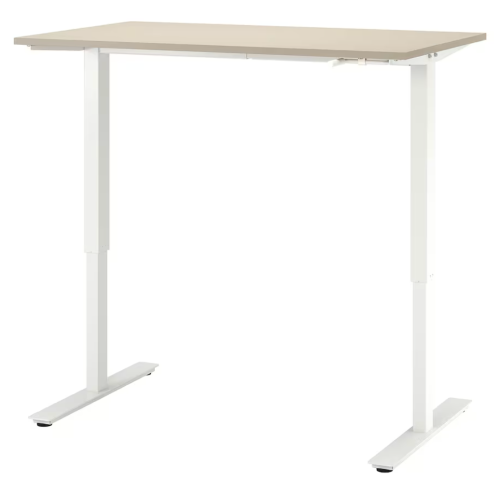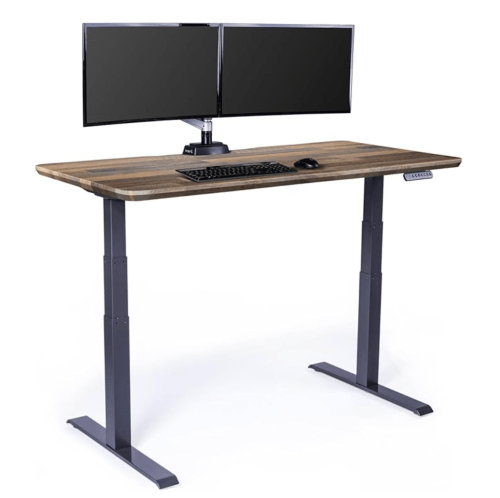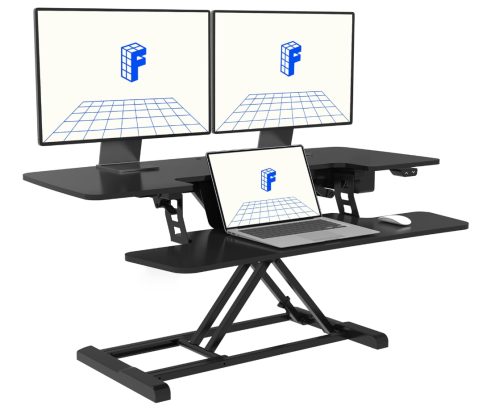‘I’m a Spine Specialist, and Here’s Exactly What I Do to Maintain Good Posture’
These small tweaks can make a big difference.

Your spine called—it’s tired of the slouching. Whether you’re sitting like a shrimp at your desk (we see you!) or craning your neck scrolling on that phone, poor posture can creep up on you quickly. And before you know it, your neck is stiff, your shoulders are tensed, and your back aches.
Experts in This Article
board-certified spinal and orthopedic surgeon based in New York City
board-certified clinical specialist in orthopedic physical therapy
With poor posture, your chest muscles tighten while your back muscles weaken. Over time, gravity takes over, pulling you forward because your muscles aren’t strong enough to hold you up. And the truth is: Poor posture can affect your spine, your balance, and even your digestion.
Fortunately, our bodies are surprisingly forgiving, and the damage isn’t always permanent. We chatted with a spine surgeon and a physical therapist to find out how to fix posture. Turns out, small tweaks can make a huge impact—and your body will notice.
How does poor posture affect your health?
Good posture plays a huge role in how our bodies function. Alex Bonhomme, DPT, a board-certified clinical specialist in orthopedic physical therapy, tells Well+Good that posture helps keep your joints, muscles, and tendons in proper alignment. “Maintaining the right body positioning can also help prevent issues like overuse injuries, sprains, strains, stiffness, tightness, and weakness,” he adds.1
Beyond these health concerns, back pain is another big one to watch for. Gbolohan Okubadejo, MD, a board-certified and fellowship-trained spine surgeon, points out that slouching puts unnecessary strain on your spine and surrounding muscles.2 This can leave you feeling constantly tired and your back aching. “Misalignment can also stress the discs in the spine, leading to issues like herniated discs,” says Dr. Okubadejo.
That forward lean while scrolling on your phone is a recipe for neck problems, Dr. Okubadejo explains. When you’re constantly looking down at screens, you can strain your neck muscles, potentially causing stiffness and tension, he explains.3 You might even get a pinched nerve, leaving you in pain and making it more difficult to move your neck.
Unexpected side effects can also affect other parts of your body. Headaches can creep in when poor posture creates tension in the neck and upper back. This happens because blood flow may be restricted, which can set off tension headaches, Dr. Okubadejo explains. Your digestive system can also take a hit. Sitting or standing with a slouched posture can compress the organs in the abdominal area, he adds. Over time, your digestion can become sluggish, eventually causing ongoing stomach issues.
But fixing your posture isn’t as complicated as you might think. Here’s what the experts suggest.
6 ways to fix your posture
Think of good posture as a daily practice. It requires regular awareness during everyday activities like sitting and standing to keep your muscles and joints in the right position, says Dr. Bonhomme. If you’re not paying attention, slouching can become your default. But these 6 tips can help you straighten up:
Retrain your muscles with simple exercises
Remember making snow angels as a kid? (And hey, if you still do as an adult, no judging!) Wall angels are exercises that do similar movements. But instead of creating winter art, you’re retraining your muscles to support good posture, says Dr. Okubadejo. They help strengthen the muscles that keep your shoulders back and your spine straight. “Performing them daily can gradually improve your posture and reduce discomfort,” he explains.
Dr. Bonhomme adds that simple moves like pulling your shoulder blades together behind your back, tucking your chin slightly as if you're nodding “yes,” and straightening your back while sitting can all help correct poor posture when done regularly.
Stretch to loosen tight muscles
“Stretching tight muscles, especially in the chest and hip flexors, can improve posture by allowing the body to realign,” says Dr. Okubadejo.
He recommends chest openers, cat-cow, and hip flexor stretches to relieve the tension from poor posture habits. Just a few minutes of these movements daily can loosen the areas that tighten up from all that sitting and scrolling.
Switch positions throughout the day
So you have a desk job—we get it! Sitting for 8+ hours is practically in your job description. But Dr. Bonhomme warns that staying in one position for hours is a recipe for posture problems. He suggests using a standing desk to break up long periods of sitting and reduce postural imbalances. Need inspiration? Here are three options worth checking out:

IKEA Trotten Standing Desk
$340
This no-frills standing desk uses an old-school hand crank to adjust between sitting and standing heights. Perfect for people who want to alternate positions without the tech complexity. Plus, the manual operation means you’re sneaking in a tiny arm workout every time you make an adjustment.

Vari Electric Standing Desk
$639
20% off
For those who can’t be bothered with manual cranking, this whisper-quiet motorized desk does the heavy lifting for you. You can switch from slouched to standing with the push of a button. This is ideal when you suddenly realize you’ve been in the same position since breakfast.

FLEXISPOT Electric Height Adjustable Standing Desk Converter
$220
27% off
So, you already have a desk you love? No problem. This option sits right on top of your desk, letting you switch between sitting and standing without replacing your whole setup. It’s a practical, budget-friendly option without the commitment of a full desk upgrade.
Try a posture corrector
For those who need a little reminder to sit up straight, Dr. Okubadejo recommends the Upright GO 2 ($64.95). This small wearable device attaches to your upper back and gently vibrates when you slouch.
“While not a long-term solution on its own, it serves as a helpful tool to develop better posture habits over time,” he notes.4 The device pairs with an app that tracks your progress and offers easy-to-follow programs to help you steadily improve your posture.
Support your neck while sleeping
Your posture doesn’t clock out when you do. The positions of your neck and lower back are both important while sleeping, says Dr. Bonhomme. Both our experts also agree that the right pillow can help keep your neck and spine aligned, preventing those annoying aches in the morning. A contoured pillow, like the Tempur-Pedic TEMPUR-Neck Pillow ($119), can help keep your neck in a neutral position, Dr. Okubadejo explains.
Still, Dr. Bonhomme adds that there isn’t a “magic pillow” that will help every person’s posture. The most important thing when choosing pillows is the thickness of the pillow, he notes. When lying on your back or side, your pillow should give enough support so that your neck remains straight—not too flexed, extended, or bent to one side.
Stay mindful of your posture
Truth be told, even with the best intentions, you’ll forget about your posture approximately 17 seconds after reading this article. Dr. Okubadejo suggests turning your phone into your personal posture coach by setting regular reminders or downloading tools like PostureMinder to give you a little nudge.
The beauty of posture awareness is that small tweaks throughout your day can help. Sitting at your desk? Check in with your shoulders. Waiting in line? Take a second to stack your spine. The more you build these habits into your day, the less you’ll have to think about them. And before you know it, good posture will just be second nature.
Other ways to protect your spinal health
Using strategies to fix your posture is a great start. But there’s more you can do to keep your spine strong and stay healthy. Our experts share a few simple ways to support your back from the inside out:
- Move it: Dr. Bonhomme says that exercise is a non-negotiable for posture improvement. Plus, they help with flexibility and reduce the risk of injury. What exercises you ask? Stretching and activities that strengthen the core, like Pilates, yoga, or weight training.5 Strong core muscles reduce strain on the spine and help maintain alignment, Dr. Okubadejo says.
- Eat your omega-3s: There’s no instant cure for back health, but Dr. Bonhomme notes that certain foods rich in omega-3 can help reduce muscle and joint inflammation. Add more salmon, tuna, flaxseeds, and walnuts to your meals to give your spine some nutritional support.
- Feed your bones: Dr. Okubadejo recommends including calcium, vitamin D, and magnesium-rich foods in your diet. “Foods like leafy greens, dairy, and fortified cereals help keep the bones strong and prevent conditions like osteoporosis,” he adds. FYI, osteoporosis is a condition that occurs when the bones become weak and brittle over time, which can affect your spine.
- Drink up: The discs in your spine need water to stay flexible and absorb shock, says Dr. Okubadejo. Not drinking enough water can lead to stiffness and discomfort. Keep that water bottle handy!
- Use spine-friendly furniture: Your back spends hours in that chair, so make it a good one. Dr. Okubadejo says chairs with proper lumbar support can reduce pressure on your spine during long work sessions. Ergonomic furniture can help maintain your spine’s natural alignment and prevent muscle strain.
- Consider supplements, if needed: While no supplement is a magic fix, calcium and vitamin D can help maintain bone density, Dr. Okubadejo says. Glucosamine can also help with cartilage repair and support joint health, keeping the spine flexible and strong, he adds.
When to see a healthcare provider
Taking steps to fix your posture can help. But sometimes, pain and discomfort are a sign of something more serious. Dr. Okubadejo recommends checking in with a professional if you’re dealing with chronic back or neck pain that sticks around despite posture fixes.
Notice your hands or feet tingling or going numb? Dr. Bonhomme says that’s not something to brush off—it could mean a nerve is getting pinched somewhere along your spine. If you’ve suddenly started getting headaches, there’s likely more going on than just slouching, Dr. Bonhomme says—so it’s a good idea to get expert help.
Dr. Okubadejo points out that if you’re experiencing stiffness, can’t move as freely as you used to, or even feel tightness in your chest when breathing, your posture might be affecting your health more seriously than you realize.
Both our experts agree that getting help sooner rather than later can save you from long-term problems. And if any of these symptoms sound familiar, it’s worth getting checked out.
- Lu, Lei et al. “Effective Assessments of a Short-Duration Poor Posture on Upper Limb Muscle Fatigue Before Physical Exercise.” Frontiers in physiology vol. 11 541974. 6 Oct. 2020, doi:10.3389/fphys.2020.541974 ↩︎
- Du, Shu-Hao et al. “Spinal posture assessment and low back pain.” EFORT open reviews vol. 8,9 708-718. 1 Sep. 2023, doi:10.1530/EOR-23-0025 ↩︎
- Guduru, Rama Krishna Reddy et al. “The Ergonomic Association between Shoulder, Neck/Head Disorders and Sedentary Activity: A Systematic Review.” Journal of healthcare engineering vol. 2022 5178333. 21 Mar. 2022, doi:10.1155/2022/5178333 ↩︎
- Kuo, Yi-Liang et al. “Sitting Posture during Prolonged Computer Typing with and without a Wearable Biofeedback Sensor.” International journal of environmental research and public health vol. 18,10 5430. 19 May. 2021, doi:10.3390/ijerph18105430 ↩︎
- Li, Fangyi et al. “Effects of Pilates on Body Posture: A Systematic Review.” Archives of rehabilitation research and clinical translation vol. 6,3 100345. 21 May. 2024, doi:10.1016/j.arrct.2024.100345 ↩︎










